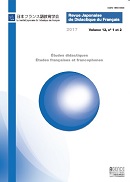17 巻, 1-2 号
選択された号の論文の33件中1~33を表示しています
- |<
- <
- 1
- >
- >|
-
原稿種別: 表紙
2022 年 17 巻 1-2 号 p. Cover1-
発行日: 2022年
公開日: 2023/02/07
PDF形式でダウンロード (565K) -
原稿種別: Appendix
2022 年 17 巻 1-2 号 p. App1-
発行日: 2022年
公開日: 2023/02/07
PDF形式でダウンロード (541K) -
原稿種別: 表紙
2022 年 17 巻 1-2 号 p. Toc1-
発行日: 2022年
公開日: 2023/02/07
PDF形式でダウンロード (595K) -
原稿種別: 本文
2022 年 17 巻 1-2 号 p. 1-2
発行日: 2022年
公開日: 2023/02/07
PDF形式でダウンロード (591K) -
原稿種別: 本文
2022 年 17 巻 1-2 号 p. 3-6
発行日: 2022年
公開日: 2023/02/07
PDF形式でダウンロード (669K) -
原稿種別: Article
2022 年 17 巻 1-2 号 p. 7-10
発行日: 2022年
公開日: 2023/02/07
PDF形式でダウンロード (574K) -
原稿種別: Article
2022 年 17 巻 1-2 号 p. 11-14
発行日: 2022年
公開日: 2023/02/07
PDF形式でダウンロード (578K)
Nº 1 Études didactiques
論文
-
原稿種別: Article
2022 年 17 巻 1-2 号 p. 15-29
発行日: 2022年
公開日: 2023/02/07
PDF形式でダウンロード (770K) -
原稿種別: Article
2022 年 17 巻 1-2 号 p. 30-42
発行日: 2022年
公開日: 2023/02/07
PDF形式でダウンロード (699K) -
原稿種別: Article
2022 年 17 巻 1-2 号 p. 43-58
発行日: 2022年
公開日: 2023/02/07
PDF形式でダウンロード (685K) -
原稿種別: Article
2022 年 17 巻 1-2 号 p. 59-75
発行日: 2022年
公開日: 2023/02/07
PDF形式でダウンロード (10270K) -
原稿種別: 本文
2022 年 17 巻 1-2 号 p. 76-87
発行日: 2022年
公開日: 2023/02/07
PDF形式でダウンロード (778K) -
原稿種別: 本文
2022 年 17 巻 1-2 号 p. 88-102
発行日: 2022年
公開日: 2023/02/07
PDF形式でダウンロード (744K)
実践報告
-
原稿種別: 本文
2022 年 17 巻 1-2 号 p. 103-117
発行日: 2022年
公開日: 2023/02/07
PDF形式でダウンロード (1233K) -
原稿種別: 本文
2022 年 17 巻 1-2 号 p. 118-128
発行日: 2022年
公開日: 2023/02/07
PDF形式でダウンロード (712K)
2021年度大会
講演
-
原稿種別: 本文
2022 年 17 巻 1-2 号 p. 129-144
発行日: 2022年
公開日: 2023/02/07
PDF形式でダウンロード (1119K) -
原稿種別: 本文
2022 年 17 巻 1-2 号 p. 145-154
発行日: 2022年
公開日: 2023/02/07
PDF形式でダウンロード (851K) -
原稿種別: Article
2022 年 17 巻 1-2 号 p. 155-160
発行日: 2022年
公開日: 2023/02/07
PDF形式でダウンロード (706K)
研究集会 日本のフランス語教育の争点2022
-
原稿種別: 本文
2022 年 17 巻 1-2 号 p. 161-163
発行日: 2022年
公開日: 2023/02/07
PDF形式でダウンロード (754K) -
原稿種別: 本文
2022 年 17 巻 1-2 号 p. 164-166
発行日: 2022年
公開日: 2023/02/07
PDF形式でダウンロード (773K)
書評
-
原稿種別: 本文
2022 年 17 巻 1-2 号 p. 167-169
発行日: 2022年
公開日: 2023/02/07
PDF形式でダウンロード (803K) -
原稿種別: 本文
2022 年 17 巻 1-2 号 p. 170-172
発行日: 2022年
公開日: 2023/02/07
PDF形式でダウンロード (776K) -
原稿種別: 本文
2022 年 17 巻 1-2 号 p. 172-175
発行日: 2022年
公開日: 2023/02/07
PDF形式でダウンロード (806K) -
原稿種別: 本文
2022 年 17 巻 1-2 号 p. 175-177
発行日: 2022年
公開日: 2023/02/07
PDF形式でダウンロード (804K)
出版物紹介
-
原稿種別: Article
2022 年 17 巻 1-2 号 p. 178
発行日: 2022年
公開日: 2023/02/07
PDF形式でダウンロード (570K)
スタージュ報告
-
原稿種別: Article
2022 年 17 巻 1-2 号 p. 179-181
発行日: 2022年
公開日: 2023/02/07
PDF形式でダウンロード (569K)
Fiches pédagogiques
-
原稿種別: 本文
2022 年 17 巻 1-2 号 p. 182-199
発行日: 2022年
公開日: 2023/02/07
PDF形式でダウンロード (1714K)
Nº 2 Études francophones
論文
-
原稿種別: 本文
2022 年 17 巻 1-2 号 p. 200-215
発行日: 2022年
公開日: 2023/02/07
PDF形式でダウンロード (699K) -
原稿種別: Article
2022 年 17 巻 1-2 号 p. 216-230
発行日: 2022年
公開日: 2023/02/07
PDF形式でダウンロード (702K)
-
原稿種別: 本文
2022 年 17 巻 1-2 号 p. 231-233
発行日: 2022年
公開日: 2023/02/07
PDF形式でダウンロード (614K) -
原稿種別: 本文
2022 年 17 巻 1-2 号 p. 234-236
発行日: 2022年
公開日: 2023/02/07
PDF形式でダウンロード (663K) -
原稿種別: 本文
2022 年 17 巻 1-2 号 p. 237-241
発行日: 2022年
公開日: 2023/02/07
PDF形式でダウンロード (682K) -
原稿種別: 本文
2022 年 17 巻 1-2 号 p. 242-248
発行日: 2022年
公開日: 2023/02/07
PDF形式でダウンロード (697K)
- |<
- <
- 1
- >
- >|
